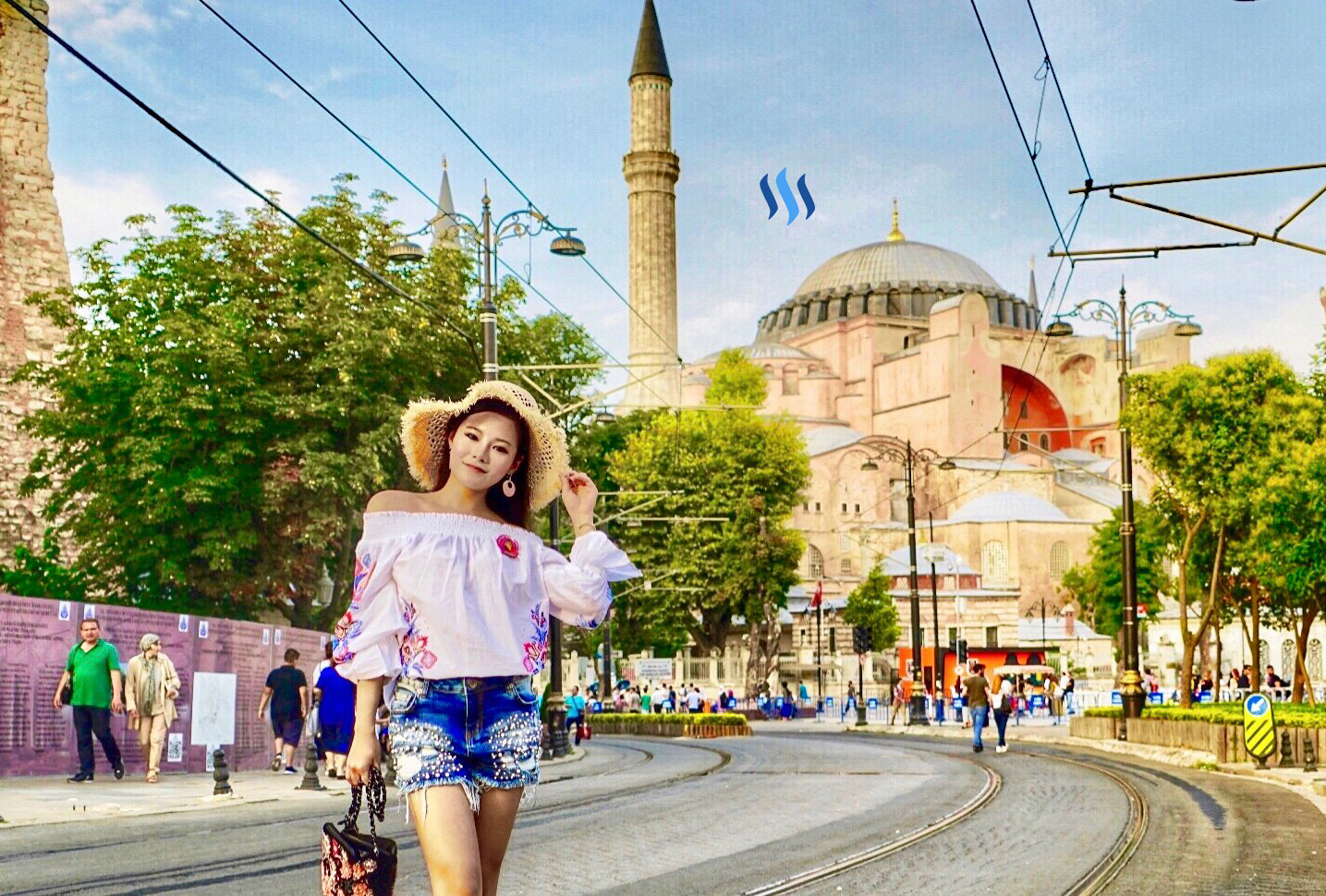
Dear Steemit Friends:
Welcome to another blog post of mine! I can't wait to connect with all of you and hope you really enjoy what I have in store for you today. You'll not believe just how amazing the landmark is that we are going to explore together. Located in Istanbul in Turkey, this iconic building has to be seen to be believed. I really hope that my photography can help you experience this beautiful landmark the same way that I did.
What is this amazing place called? Hagia Sophia. Stay right to the end to see it as you've never experienced it before!

Right next to the Blue Mosque that we saw in my last post, the imposing Hagia Sophia has a long, rich and colourful history. 'Hagia Sophia' is derived from the Greek for Holy Wisdom, which reflects its roots as a Greek Orthodox Christian cathedral. First built in 537 AD, it was the largest building in the world at the time.
You can see has a very distinct dome shape, which was particularly unique at the time. Though we now see this dome shape often in Islamic architecture, this building style wasn't always as common. When first built, Hagia Sofia would have been truly unique. The dome shape only became widely synonymous with Muslim architecture during the Ottoman empire, when the Sultans realised that a unified religious architecture would help unify the empire. They chose the dome shape to be one of their iconic structural shapes and they are now founds all over the world where Muslims worship.

For 900 years Hagia Sophia was an orthodox cathedral and served as an important place of worship and religious governance until 1453 when it then became a mosque under the Ottoman empire. Amazingly, it is even larger than the Blue Mosque even though the mosque was built 1000 years later. It truly is a wonder of design and architecture for a building so old. It inspires and dominates the skyline even now, so in 537 AD it must have left those who visited it in complete awe.

Hagia Sophia is mostly built from small bricks and mortal, which makes it look to me a bit more rustic than buildings cut from large stone blocks. A bit like someone started off wanting to build a house and then just forgot to stop building! It only took five years to build, and replaced another church on the same site. That church was constructed mostly of wood, and thus it burned down to the ground in 532 AD. Emperor Justinian the 1st immediately commissioned the construction of a new church on the site, which was to become Hafia Sophia as we know it today.

An amazing feat of engineering, historical records tell us that construction took over 10,000 workers to build. Unfortunately, only 35 years later the dome suffered damage after a major earthquake, and collapsed in 558. Historians believe the collapse was blamed on the dome being too 'flat'. The emperor commissioned an architect named Isidorus to fix the roof. He used lighter materials and increased the arch of the roof to create a stronger shape. This dome has now stood since 560 AD!


Hagia Sophia's 82m length and 73m width isn't just comprised of the main dome. There are also additional structures and buildings that make up the entire area. I found walking around the building, not just seeing the standard front view, to be fascinating.
Venturing inside the majestic domes of Hagia Sophia

Venturing inside, I was as impressed with the beautiful interior as much as the exterior. The building is no longer a centre for religious activities as it has been for thousands of years - it is now a museum. This means that elements from both Christian and Muslim history have been preserved within, making it a fascinating place to explore.

I knew that Hagia Sofia was famous for its great columns and mosaics, but I don't think anything can prepare you for the scale and complexity of them. The vaulted dome ceilings, with the soaring columns, look more like the inside of a cathedral. However, that symbolism is then mixed in with many different elements from the Islamic history of the building. It makes for a truly unique mix of different designs found together in very few places in the world.
The gold on the mosaic in the vaulted dome above makes the ceiling seem to almost glow, shining a beautiful golden light down onto those of us standing below.

From the outside, the central dome dominates your focus. Inside, however, you realise that there are in fact multiple domes that interconnect. Each one is decorated different to the other, with gold colours and religious imagery being the most common colours and motifs. Holding up the massive ceiling are the beautifully stacked, carved and decorated columns. Standing under the 55m central dome, admiring the immensity of Hagia Sophia, I did feel very small and humbled.

Stop! Look very carefully. I wasn't just taking photos of a bunch of random people... I found a fury friend, in the last place I'd have expected! Up at the front of the giant ex cathedral I noticed the cutest little cat. He looked like he had positioned himself in front of the crowd, ready to give a speech! Perhaps he is the caretaker of the building and wanted to address the gathered crowd about the proper conduct while visiting.
He looked completely un-concerned by his upcoming public address, but I thought I was worried he might run off if I approached him too quickly. I did hang back for a bit, my eyes drawn between wanting to admire the majestic domes and columns further, and wanting to go and meet The Caretaker. I decided that the building had already been standing for well over 1000 years, so it would probably still be there in a few minutes after I'd gone and made a new friend.
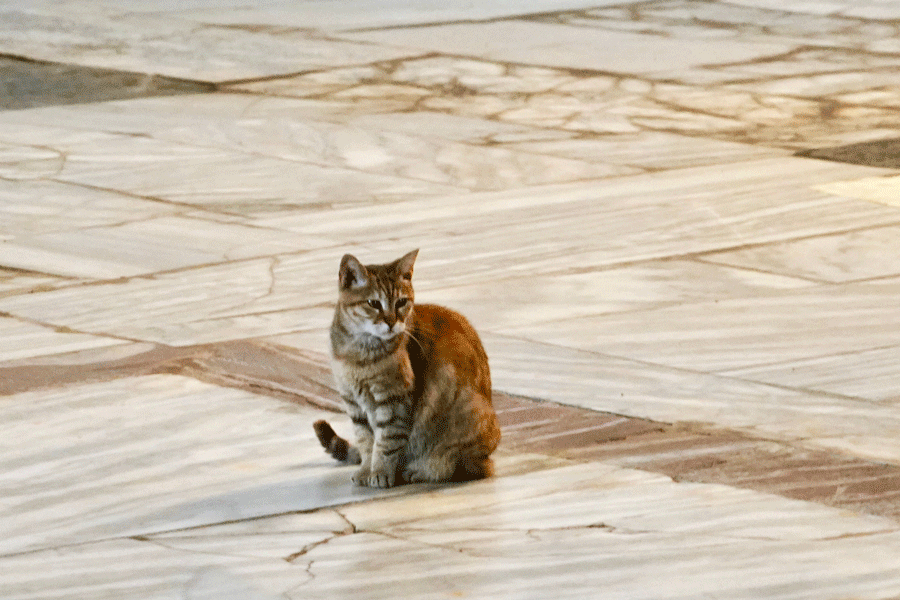
I got a little bit closer to 'The Caretaker', and after he had meowed his instructions to the waiting crowd, I wanted to go and meet him. He seemed like such a friendly little cat and I knew he must be quite used to visitors. I think he knew how cute he was as he was almost posing for the camera!
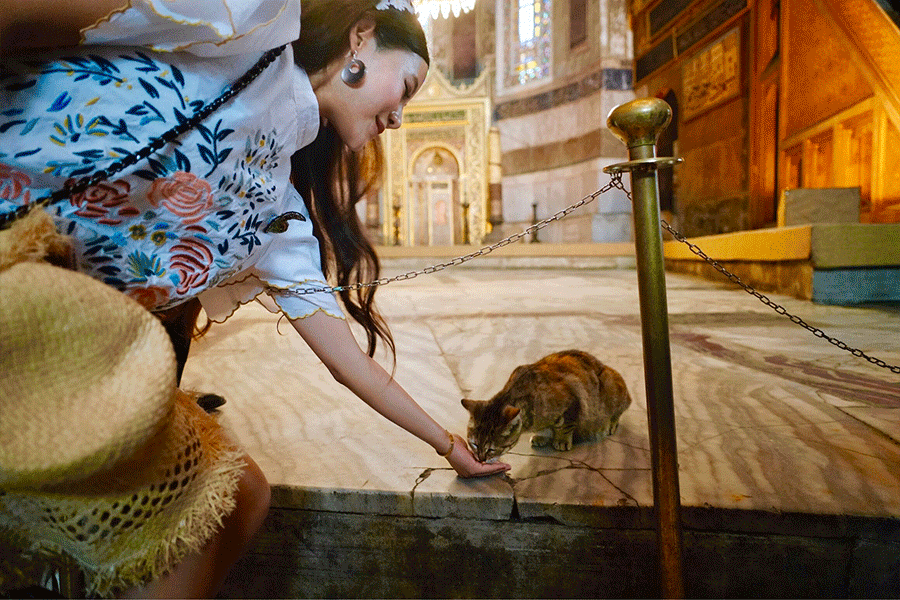
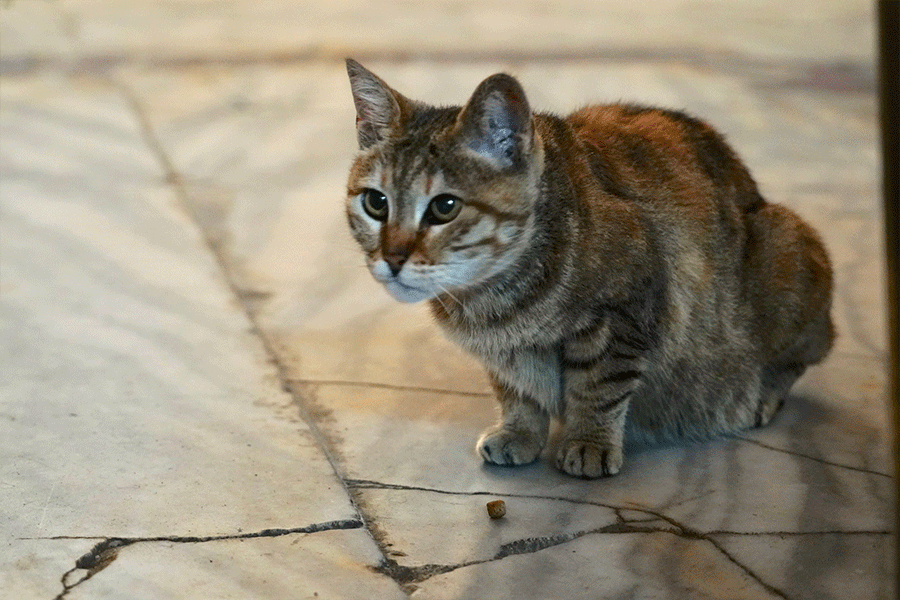
I loved making a new little furry friend. He must get looked after very well by tourists. As much as I joke about him being The Caretaker, I did wonder if he was a stray that just wanders into the building through some secret entrance each day, or if he belongs to the museum. He seemed completely un-phased by all of the people around him, though he was quite timid when coming to get food. Because of that I suspected that he was a stray, because he had 'street' instincts, but must have visited regularly. What a beautiful little man! So good to meet him. I knew he'd be supervising all of the tourists in Hagia Sophia and making sure we all enjoyed ourselves.

As you can see from the photo here, there was some pretty extensive restoration work going on during my visit. In such an old building it is essential that the structure is kept strong and safe for all of the visitors, and the preservation of such a landmark. This is especially important since the the history of Hagia Sophia is marked by regular earthquakes and earthquake damage. The building is a UNESCO world heritage site and has seen extensive renovations since receiving the prestigious status in 1993.
On top of that, there's the priceless art that adorns every surface of the building's walls and ceilings. Everything from the sun to damp to tourists can cause damage to these pieces of work. They could never be replaced so they must be restored. The museum does a great and unending job of maintaining the splendour of the building.
Let's take a closer look...

Within the walls of Hagia Sophia there is so much to see, all of which is extremely interesting and spectacular. In this section I want to take you on a little tour of all of the little details that I noticed within the museum to give you a better sense of the place. For example, look at these amazing chandeliers that are found suspended from the huge domed roofs, providing light and a sense of grandeur to the already majestic space.

Some areas are so fragile that tourists can't go near them or walk on them because they could suffer damage or general wear overtime. I also wished I could have read what some of the amazing text said. The art and style are so beautiful but I had no sense of the meaning. Can anyone help me out with the meaning behind the large text and symbols on the giant circular green paintings in the photo here?

Close up of another beautiful chandelier with the incredible colours of the ceiling behind

Me for scale to show how large this light was!

Holding up many areas of the ceiling were columns, but not just boring stone columns. Even these were ornately decorated, and as you can see behind me here, plenty of gold still featured here too. I loved the contrast between the white stone columns and the gold coloured metal dividers separating this private area of the cathedral/mosque/museum off.

Even the doors are massive, as you can see here! In ancient times, the cathedral served as a place of safety for those fleeing persecution. By law, the religious status of the building allowed it to be safe from attackers and anyone seeking to do harm on people. Many people harboured themselves safely here over the years, and perhaps these really big doors helped keep them safe too!

Some of the mosaics that adorn the vaulted ceilings

This doorway was fascinating. At one time, it looked like it had actually been a door, but the door had been replaced with a stone carving. Next to the large door stood a smaller door, which still had an opening. I wondered at what point in history the door had been removed, and replaced by a carving? Why close the door up, and if you needed to, why not just put a wall instead of a fake door? The carving was so good that from a distance it just looked like a normal door.
Has anyone else ever come across doors that were carved but not real doors? Do you know why this might have been done? Let me know in the comments below!

Some of the most famous art works within the museum were the mosaics. These mosaics were incredibly intricate and are some of the greatest surviving examples of such art work in the world. Most of these exhibits were found in the upper gallery of the building and as can be seen from the photos, many of them are incomplete. This is because over time there has been many different natural events as well as simple time, that has caused damage to these beautiful works. The museum, however, now takes great pains to preserve the historic works.


Above in the bottom left is one of the most famous mosaics. It shows a triumphant infant Jesus, next to John the Baptist.

A different depiction of the same scene as above


You could spend literally hours searching through the halls, galleries and central chambers of Hagia Sophia. There is art, architecture and beauty, every place you look. The range of different eras that are represented here reflect the long long history of the place. According to experts, there are still areas below the church that have not been fully explored. They are submerged under water and are currently inaccessible. In the adjacent buildings there are buried the remains of five different Sultans of the Ottoman empire, so imagine what secrets could be buried in the tunnels below the museum. I'd love to find out!

Getting a crazy Uber around Turkey's largest city

After hours exploring Hagia Sophia it was time to reward myself with a big dinner! I decided to head back to Istinye Park, a huge shopping centre in Istanbul that I have taken you to see with me before. Last time we had some amazing French food in a funky bright cafe, but this time I thought I'd try something a little more casual. It was quite a way away so I decided to call myself an Uber to take me there, and you'll never guess what turned up...

Cruising through the massive city of Istanbul, a city of over 15 million people, I had some amazing views of the city. But I also had some amazing views inside too! Just look at these cream leather seats! This was the most crazy Uber that I had ever been it. I couldn't believe that this was basically a 'taxi'! However, I discovered later in my trip that this wasn't a one off lucky chance. Over the course of my stay in Istanbul I used many different Ubers and found that this style of Uber was almost the normal type! Just look at some of these other crazy cabs that I took.

This one had a giant light on the ceiling, like an ornate painting, as if we were in a Las Vegas casino, complete with red lighting all around!

Racing red seats and brown leather seats to match my shoes!

Getting some casual food after a long day in Istinye Park
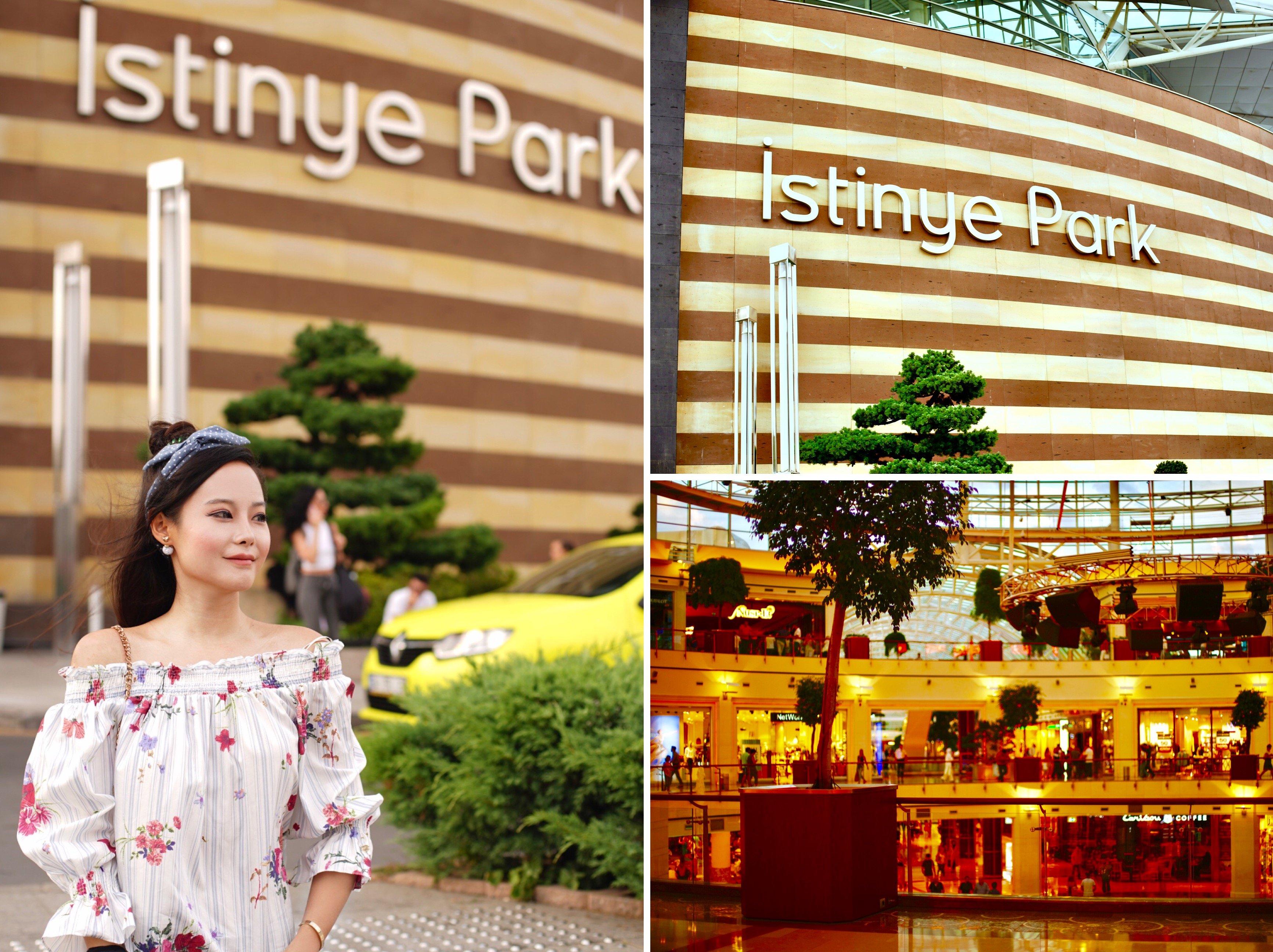
Istinye Park is what I would consider a mega shopping centre. It has over 300 stores, four levels of underground parking just for the shopping centre, and 85,000m² of retail area. It even has an open air area complete with park and dozens of restaurants. First opened in 2007, it has become a massive attraction for both tourists and locals alike.

The design of the building is amazing. It's absolutely huge and has everything from trees to a waterfall inside the massive glass arched roofs. Having been here before and having eyed up a few different places to eat, I didn't take long to look around. I needed to get some food in my tummy, because I was hungry!

I settled on Gunaydin Steakhouse because it looked like somewhere I could get some food, quick! With a range of different foods, and plenty of meat on the menu, it wasn't hard to pick a bunch of different dishes to satisfy my taste buds.

Half restaurant, half fast food canteen, it still had a great vibe. I felt like of like I was in a food court, that you get in these big shopping centres, but Gunaydin Steakhouse had its own little section off to the side with its own tables and decorations. You still ordered your food up at the counter and took it to your table, though, as you would in a food court.


Since it was a steak house I definitely had to order some meat. So I got some beef as well as some beautiful side dishes and soup. I loved the side salads with the big serving of meat, so I felt quite virtuous (as well as really full). The desserts were a little bit... pre-made. They tasted OK but you could tell they had perhaps been made the day before or had been sitting there for a long time. With that said, they were still pretty good after a long day of sight seeing!

As you can tell... I was pretty hungry! That's the smile of a full tummy
I hope so much that you enjoyed this epic post about the amazing Hagia Sophia. I told you you would see shots of this historic building, like you'd never seen before. And here they are. On my way back home after dinner, I saw the sun setting and since I was passing close to the historic landmark, I wanted to go and see it in the orange sunlight.
The view was even better than in the day. The rays of sun bouncing off the red stone brick made it look even